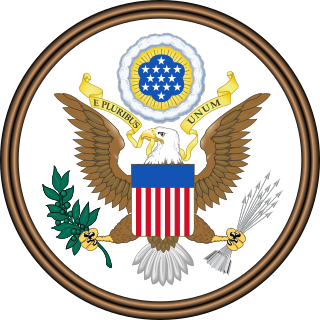
The Misuse of Drugs Act 1971 is an Act of the Parliament of the United Kingdom. It represents action in line with treaty commitments under the Single Convention on Narcotic Drugs, the Convention on Psychotropic Substances, and the United Nations Convention Against Illicit Traffic in Narcotic Drugs and Psychotropic Substances.
Misuse of Drugs Act is the name of several similar national drug control laws passed by countries in the Commonwealth of Nations and by the Republic of Ireland. With the exception of Ireland's 1977 Act, they all sort drugs into three categories, Classes A, B, and C. This classification system was influenced by the Single Convention on Narcotic Drugs and other drug control treaties.

Cannabis classification in the United Kingdom refers to the class of drugs, as determined by the Misuse of Drugs Act 1971, that cannabis is placed in. Between 1928 and 2004 and since 2009, it has been classified as a class B drug. From 2004 to 2009, it was a class C drug. At present, it is a class B, with very limited exceptions.
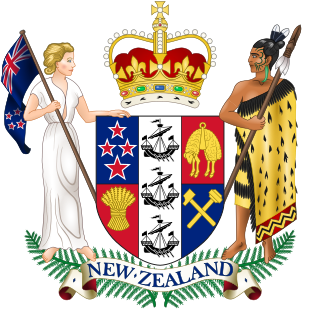
The Misuse of Drugs Act 1975 is a New Zealand drug control law that classifies drugs into three classes, or schedules, based on their projected risk of serious harm. In December 2018, the Labour-led Coalition Government passed a law permitting the used of medical cannabis for terminally ill patients.
The United Kingdom Misuse of Drugs Act 1971 aimed to control the possession and supply of numerous listed drugs and drug-like substances as a controlled substance. The act allowed and regulated the use of some Controlled Drugs by various classes of persons acting in their professional capacity.
The Medicines Act 1968 is an Act of Parliament of the United Kingdom. It governs the control of medicines for human use and for veterinary use, which includes the manufacture and supply of medicines.

para-Fluorophenylpiperazine is a piperazine derivative with mildly psychedelic and euphoriant effects. It has been sold as an ingredient in legal recreational drugs known as "Party pills", initially in New Zealand and subsequently in other countries around the world.

MBZP (1-methyl-4-benzylpiperazine) is a stimulant drug which is a derivative of benzylpiperazine. MBZP has been sold as an ingredient in legal recreational drugs known as "Party pills", initially in New Zealand and subsequently in other countries around the world.
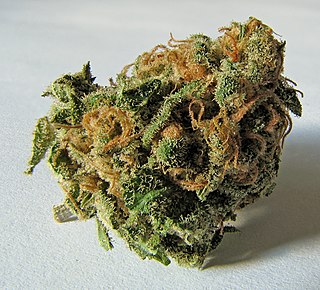
The use of cannabis in New Zealand is regulated by the Misuse of Drugs Act 1975, which makes unauthorised possession of any amount of cannabis a crime. Cannabis is the fourth-most widely used recreational drug in New Zealand, after caffeine, alcohol and tobacco, and the most widely used illicit drug. In the population of more than four million, 13.4% of those aged 16–64 use cannabis. This ranks as the ninth-highest cannabis consumption level in the world.
Drug prohibition law is prohibition-based law by which governments prohibit, except under licence, the production, supply, and possession of many, but not all, substances which are recognized as drugs, and which corresponds to international treaty commitments in the Single Convention on Narcotic Drugs 1961, the Convention on Psychotropic Substances 1971, and the United Nations Convention Against Illicit Traffic in Narcotic Drugs and Psychotropic Substances 1988.
The Runciman Report was a 2000 Police Foundation (2000) inquiry into the United Kingdom's Misuse of Drugs Act 1971 (MDA) authored by Viscountess Runciman.

2-Diphenylmethylpyrrolidine (Desoxy-D2PM), also known as 2-benzhydrylpyrrolidine, is a stimulant psychoactive drug. It is the 4-dehydroxylated structural analog of diphenylprolinol (D2PM), and is also similar in structure to desoxypipradrol (2-DPMP), both of which act as norepinephrine-dopamine reuptake inhibitors (NDRIs). Like D2PM and 2-DPMP, Desoxy-D2PM is sold as a designer drug and has been used in the manufacture of legal highs. It has been marketed under the names A3A New Generation, A3A Methano, and Green Powder, and has been reported to cause hallucinations, violent behavior, dilated pupils, tachycardia, and high blood pressure. Literature data suggest that it can produce the same psychotropic effects as other stimulants, but with a longer duration of action.
The Drug Equality Alliance is a not for profit organisation based in the United Kingdom whose mission statement is:
[...] to transform the "War on Some People who use Some Drugs" from its subjective historical and cultural roots into a rational and objective legal regulatory framework that secures equal rights and equal protection to all those who are concerned with dangerous or otherwise harmful drugs. Our mission is to use domestic and international legal jurisdictions to interrogate the law and its application to those who produce, commerce, possess and consume such drugs.
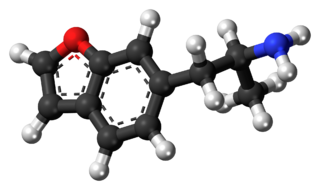
6-APB is an empathogenic psychoactive compound of the substituted benzofuran, substituted amphetamine and substituted phenethylamine classes. 6-APB and other compounds are sometimes informally called "Benzofury" in newspaper reports. It is similar in structure to MDA, but differs in that the 3,4-methylenedioxyphenyl ring system has been replaced with a benzofuran ring. 6-APB is also the unsaturated benzofuran derivative of 6-APDB. It may appear as a tan grainy powder.
While the drug never became particularly popular, it briefly entered the rave and underground clubbing scene in the UK before its sale and import were banned. It falls under the category of research chemicals, sometimes called "legal highs." Because 6-APB and other substituted benzofurans have not been explicitly outlawed in some countries, they are often technically legal, contributing to their popularity.
Drugs considered addictive or dangerous in the United Kingdom are called "controlled substances" and regulated by law. Until 1964 the medical treatment of dependent drug users was separated from the punishment of unregulated use and supply. Under this policy drug use remained low; there was relatively little recreational use and few dependent users, who were prescribed drugs by their doctors as part of their treatment. From 1964 drug use was decreasingly criminalised, with the framework still in place as of 2014 largely determined by the Misuse of Drugs Act.
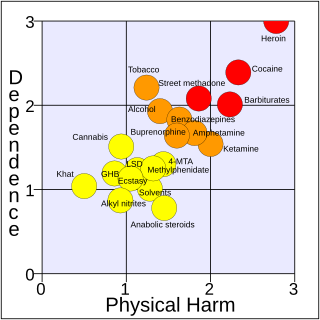
Drug harmfulness is the degree to which a psychoactive drug is harmful to a user and is measured in various ways, such as by addictiveness and the potential for physical harm. More harmful drugs are called "hard drugs" and less harmful drugs are called "soft drugs". The term "soft drug" is considered controversial by its critics as it may imply that soft drugs cause no or insignificant harm.
